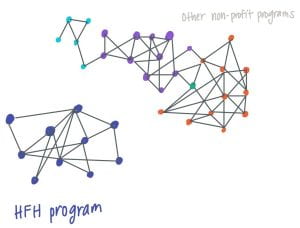The Advantages of Networked Nonprofits
The concept of a ‘networked nonprofit’ is a practical lens to understand how organizations need not be very large with a plethora of their own internal capabilities in order to bear a lot of impact and output. It’s all about how organizations are able to leverage existing resources in order to share their work with other partners that have the same goals. Therefore, based on the success of networked nonprofits (according to an article in the Stanford Social Innovation review), “organizations should focus less on growing themselves and more on cultivating their networks” (Source).
The authors of the article use the example of Habitat for Humanity International to illustrate their point. A typical Habitat for Humanity program builds about 200 shelters per year, but the Habitat for Humanity Egypt program has managed to build about 5x as many shelters per year. What are they doing differently than the rest of the HFH programs that has given them such an advantage? The answer is that they have shifted their productivity focus from internal to external, meaning less fundraising and staff recruitment focuses and more external networking focuses with other community-based organizations to help fill in any “gaps” they have in their resources/capabilities.
One can further understand why this approach is much more effective when incorporating topics from our own class material. We could think about an extreme hypothetical example of a HFH program where it does not have any partner/community-based org connections. The HFH program would be a component in a large network of community-based orgs. The HFH component in this network might have similar goals and varied resources to the other components, but it would not know because it is not connected to them or shares common edges. This could cause the HFH program component to spend a lot of valuable time building out capabilities that another component/organization might already have and be willing to share. Another disadvantage of isolated components in a network of nonprofits is that there is less sharing of information that could be crucial to accomplishing their goals and missions. If the HFH component were to have no neighbors, then it means they would have no communication with the other potential partners and they would miss out on developing more holistic, coordinated, and realistic solutions through joint knowledge. The more edges between nodes in the nonprofit network, the better, because it signifies a maximization of unrestricted communication and flow of social capital.
https://ssir.org/articles/entry/the_networked_nonprofit

